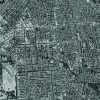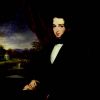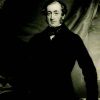Of all the streets named on 23 May 1837 Carrington Street has been one of the more difficult to research. The reasons for this are many, and after a long and arduous exploration there are now sufficient reasons to conclude that the street ought more rightly be called Abel Smith Street and not Carrington Street, although John Abel Smith may not have thought so.
Ironically, the two are almost synonymous because the first Lord Carrington (1752–1838) was in fact the uncle of John Abel Smith MP (1802–1871) and they were both descendants of Abel Smith (1717–1788), the famous banker of Nottingham who presided over the company of Smith, Payne and Smiths, amassing great wealth from the middle of the eighteenth century onward. It was a great dynastic family and as a result there were no less than twelve Smiths serving in the parliament over several decades during the period of reform, some of them simultaneously. They were all members of the Smith/Carrington dynasty, which came to be headed by the 1st Lord Robert Carrington of High Wycombe in 1796. King George III usually objected to elevating tradesmen; that is, merchants, bankers and the like to the peerage. However, on this occasion Prime Minister William Pitt was at his most persuasive and towards the end of the eighteenth century this new Smith dynasty rose to aristocracy.
On the day the streets were named by the committee of twelve it was listed simply as Carrington Street, there being no clue other than location on the plan as to why it might have been so named. Given that many of the streets were paired in a way which reflected the contribution each person made on behalf of the colony, it looks as though two of London’s banking houses were seen in this light and thought of as a pair, namely Wright and Carrington streets. The two banks were Wright & Co. and Smith, Payne and Smiths. This makes some sense, as they were both dynastic and strongly committed to the colonial experiment, financially and philosophically. When looking elsewhere on the street grid, further pairing of this nature is evident. While this conclusion is logical, it doesn’t explain why there have been conflicting attributions for Carrington Street in several publications for nearly 180 years.
The Corporation of the City of Adelaide is partly responsible for the confusion. Thomas Worsnop, the Town Clerk at the time of the jubilee in the late-nineteenth century, attributed the street name to both Lord Carrington and his nephew John Abel Smith. Both are listed. This was probably a fair attribution but not explained. Each name was simply separated by a comma and no other information provided. This information was taken from Adelaide City Council records and referred to in a paper Geographical Nomenclature of South Australia presented at the 1893 meeting of the Australasian Association for the Advancement of Science, in Adelaide.
Subsequently, in the 1930s, the Corporation of the City of Adelaide misinterpreted this attribution and began to repeatedly list an entry in its annual Municipal year book as follows: ‘Lord Carrington, formerly Robert Smith, a parliamentary associate of the Duke of Wellington’. Unfortunately, they dropped the reference to John Abel Smith and inadvertently drew attention to the fact that Lord Carrington had earlier, in his parliamentary career, given his proxy vote to the Tories through the Duke of Wellington. This further added to the confusion, for the Smith members of parliament were generally Whigs with an inclination towards the more liberal side of politics. While the Duke of Wellington was a Tory and a hardened conservative, he did support the South Australia Act 1834. John Abel Smith MP, Lord Carrington’s nephew on the other hand, was especially radical. He was an untiring supporter of George Grote, deeply committed to the Philosophical Radicals and, known to both George Grote and his wife Harriet.
The confusion did not end there. Several publications in the twentieth century especially devoted to place names in South Australia simply perpetuated the name Carrington and the presumption that it was Lord Robert Carrington, usually with no further explanation. More recently, and with the advent of the internet, there has been a proliferating repetition of the erroneous claim that John Abel Smith was in fact Lord Carrington. This is unfortunately incorrect.
Lord Carrington was in his mid-80s when the streets of Adelaide were named and therefore hardly in a position to be closely associated with the South Australian Colonization commissioners in London in any active capacity. He was, however, the titular head of the Carrington/Smith dynasty. John Abel Smith, on the other hand, was deeply involved with the colonial project. He was an associate of Robert Gouger, who he appointed as his agent in South Australia; an inaugural member of the National Colonization Society; a friend of the Grotes; an associate of William Wolryche Whitmore, Colonel Robert Torrens, John George Shaw Lefevre and others; a member of the Political Economy Club between 1821 and 1834; and a close confidant of Edward Gibbon Wakefield, with a relationship spanning more than thirty years. He could not have been more deeply involved in the South Australian experiment.
Although my position is to some extent speculative, I think that John Abel Smith was instrumental in having the street called Carrington Street. Being of an imaginative and vivid personality, it is in my opinion named after the dynasty, rather than one particular individual. Robert Smith (Lord Carrington) was the first in the family to be elevated to the peerage and it is conceivable that John Abel Smith fancied himself as a member of the aristocracy. Furthermore, with such a common name as Smith it is possible that many, if not all the members of the family began to think of themselves as Carringtons throughout their formative years, if only to set themselves apart from so many Smiths in England and Britain. They were certainly raised as young aristocrats in decidedly wealthy circumstances.
John Abel Smith, our subject, is best described as a radical politician of good breeding with a background in banking and a penchant for overseas investment in colonial development, most frequently in the expanding British Commonwealth.
He was born 2 June 1802 at Dale Park, the extended family home of the Carrington/Smith dynasty, near Arundel in Sussex. As the eldest son of John and Mary Smith (nee Tucker, 1767–1842) he received patronage from both his father John and his uncle Robert Smith, the 1st Lord Carrington (1752–1838) in the modern era. Mary was his father’s second wife.
John Abel Smith and his father were indebted to Lord Carrington for their seats in parliament prior to the Reform Bill because as a Lord in possession of some very large estates he held two pocket boroughs, namely the seats of Wendover and Midhurst, which he used as patronage. The Smiths had ‘owned’ seats in parliament for more than four generations and John Abel Smith was to be no exception, there being an expectation that after a good education he would rightfully take his place in the House of Commons. For this family it was a rite of passage.
Smith was educated at Eton College between 1814 and 1818 and matriculated in 1819. He spent the next two years coming to terms with some inner turmoil about who he was and where he wanted to go in life, before eventually finding a way forward among the more radical cognoscente in and around London. David Ricardo, James Mill, Thomas Malthus, Colonel Torrens and Grote were so impressed with Smith and his intellectual capacity that he was invited to join the restricted membership of the inaugural Political Economy Club in 1821 – the august group of thinkers and theorists who met regularly to exchange ideas and present formal papers on the economy, free trade, capital movement, the Gold Standard, currency, the Corn Laws and agricultural and industrial output. With the Club’s membership limited to 35 people, Smith remained a member until 1834. He was invited to join from the outset when only 19 years of age, which probably made him the youngest of the inaugural members.
Smith when he went to Christ’s College at Cambridge in 1822. He graduated in 1825 and rounded off his education with travel to France and Switzerland, when it is said he began to find himself as a person.
On 26 December 1827 John Abel Smith married a young widow known as Anne Grey (nee Jervoise). She has been described as a ‘particularly fascinating’ salon hostess who brought two stepchildren to the union. John and Anne had three further children, all boys: Jervoise (1828–1884) Dudley Robert (1830–1897) and Hugh Colin (1836–1910). All three were bankers.
John Abel Smith’s father took over the seat of Buckinghamshire in the new parliament and Smith successfully won his father’s earlier seat of Chichester. He went on to enjoy a very long political career, pleasing this constituency for a total of 33 years – successively winning between 1831 and 1859 and then again from 1863 to 1868.
Generally speaking, Smith took a liberal stance on most issues, but history records his greatest contribution lay in his support for the admission of Jews to the parliament. This was a natural inclination resulting from his long association with several Jewish banking conglomerates including that of the Rothschilds. It took from the early 1830s before Jews were admitted without discrimination. Smith’s part in this is legendary. The Smith family bankers had been associated with the Rothschilds for years. They were heavily linked to banking in London and may have assisted the Rothschilds in raising the millions of pounds required as reparation to plantation owners when slavery was abolished throughout all British possessions in 1833.
Smith joined the family bank of Smith Payne and Smiths at about the time he married. He became a senior partner along with his father John, his uncle Robert Smith, the 1st Lord Carrington, his half-brother Martin Tucker and his cousin, Abel Smith in 1835. As bankers they were extremely successful. Smith, however, was considered to be a little too adventurous with some of his business ideas and only remained with the bank until 1845. Most of his ideas for capital investment arose from the ideology and experimentation of the liberal radical elite. Wakefield was especially indebted to him and they remained intimate friends for more than thirty years.
Smith first became associated with Wakefield in 1829. It may have even been while Wakefield was still in prison that Smith had contact because, like his uncle Lord Carrington, he was also a member and Vice President of the London Refuge for the Destitute, a charitable organisation which assisted prisoners in their rehabilitation, especially young men and women. Smith somehow became caught up in this and as a result was among the large number of young, idealistic intellectuals who joined Wakefield’s National Colonization Society in 1830.
In some ways, Smith and Wakefield were similar in character, bouncing schemes and opportunities off one another. There is little doubt Smith supported the South Australia Act in the parliament as it became law in 1834. It was soon afterwards, and at the point the South Australian experiment began, that he appointed Gouger, the Colonial Secretary, as his agent in Adelaide. This netted Smith several properties in the colony including town acres in Grenfell Street (lot 141), Pirie Street (lot 170), Flinders Street (lots 230, 231, 271, 272) and Melbourne Street (lots 985, 986). These purchases also entitled him to more than 640 acres of rural land.
Smith’s business projects were numerous; some successful, some ending in monetary loss but always exciting and interesting. Besides a commitment to both the South Australian and New Zealand experiments he was at various times both the Treasurer and a director of the East and West India Dock companies, the first Chairman of the Australian Agricultural Company, a partner in the London merchant house of Magniac, Smith and Co., an investor in the portside development in the town of Fleetwood, Lancashire, a director in the Edinburgh Life Assurance Company (1842–67), and for a brief time a director of the University Life Assurance Society. He was also a director of the Australian Trust Company, which formed in 1840.
Beyond the investment opportunities he sought abroad, Smith’s community and parliamentary interests were several. He was a member of The Penny Magazine committee, an initiative of the Society for the Diffusion of Useful Knowledge. In 1836 he was sworn in as a member of the Metropolitan Commission in Lunacy and much later in his parliamentary career took a special interest in the matter of the licensing laws for the consumption of alcohol. As a member of the parliamentary committee on Sunday drinking, which was coincidentally chaired by Sir James Fergusson, who would later become Governor of South Australia, Smith worked hard with colleague Matthew Hill to bring in a Bill against it. As an elderly parliamentarian Smith was also a member of the Ritualistic Commission.
John Abel Smith lived for most of his adult life in Belgrave Square, London. He was not averse to opening his home to a large social circle for parties and balls. Sometime after 1853 Smith purchased a country house at Kippington, in Sevenoaks, where he died on 7 January 1871, in his 69th year.
South Australians will in a small way be ever indebted to Smith, especially in a financial sense. When the economic crisis of 1840 hit the colony, the British Government set up a Select Committee to investigate all the issues which might have contributed to what was seen as a pending disaster. Smith was on this committee and through his banking connections helped South Australia to remove all the debt owing to the British Government.
John Abel Smith’s contribution to social reform in Britain and the help he gave to South Australia was significant. He died leaving an estate of some £40,000, which was only a fraction of that left by some of his siblings and other members of the Smith/Carrington dynasty.







Comments